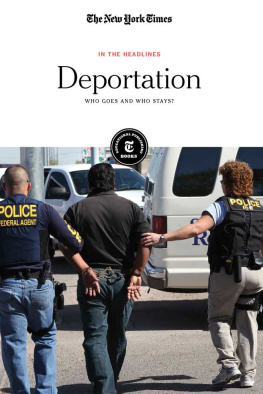
Published in 2021 by New York Times Educational Publishing in association with The Rosen Publishing Group, Inc.
29 East 21st Street, New York, NY 10010
Contains material from The New York Times and is reprinted by permission. Copyright 2021 The New York Times. All rights reserved.
Rosen Publishing materials copyright 2021 The Rosen Publishing Group, Inc. All rights reserved. Distributed exclusively by Rosen Publishing.
First Edition
The New York Times
Caroline Que: Editorial Director, Book Development
Cecilia Bohan: Photo Rights/Permissions Editor
Heidi Giovine: Administrative Manager
Rosen Publishing
Megan Kellerman: Managing Editor
Michael HesselMial: Editor
Brian Garvey: Art Director
CataloginginPublication Data
Names: New York Times Company.
Title: Restorative justice: an alternative to punishment / edited by the New York Times editorial staff.
Description: New York: New York Times Educational Publishing, 2021. | Series: In the headlines | Includes glossary and index. Identifiers: ISBN 9781642824155 (library bound) | ISBN 9781642824148 (pbk.) | ISBN 9781642824162 (ebook) Subjects: LCSH: Restorative justice United States. | Discrimination in criminal justice administration United States. | Antiracism United States. | Race awarenessUnited States. Classification: LCC HV8688.R478 2021 |
DDC 320.973011dc23
Manufactured in the United States of America
On the cover: Educators and administrators take part in a restorative justice training session at Lakeview Elementary School auditorium on March 14, 2013, in Oakland, Calif.; Ann Hermes/ The Christian Science Monitor/Getty Images.
Contents
Introduction
GOVERNMENTS FROM THE local to national level do a great many things, but one common feature of them all is the authority to use force. Individual citizens cannot possess nuclear weapons or imprison people; only a governing authority is granted that right. Democratic societies are designed, moreover, to give ordinary citizens some degree of a voice in how that right to use force is used. Democracies are premised on the idea that the people ultimately decide although often in an indirect way how and whether a government may restrain, punish or kill.
Its a serious responsibility. Our laws decide what kinds of behaviors are considered crimes, which crimes deserve harsh punishments and which crimes deserve leniency. Those laws have tended to change with our social values. We look back at some old laws with puzzlement, as in a New Jersey law requiring all horses to wear sleigh bells, and disappointment, as in laws banning interracial marriage. The sillier laws reflect some longpast public interest, and the oppressive laws remind us whose needs were neglected.
Future generations may look back at Americas legal system with puzzlement and disappointment. Since the 1970s, when President Richard Nixon expanded federal funds for policing, and the 1980s, when President Ronald Reagan launched the first of several tough on crime laws, American criminal justice has been characterized by heavily militarized policing and harsh punishments for crimes. Today, the United States has the highest incarceration rate in the world. It also has more killings by police officers than those in Mexico, Pakistan, Argentina or Egypt. And Americans arent necessarily safer for it. While the United States did experience a crime wave that prompted this initial incarceration and policing boom, criminologists disagree whether these punitive measures had any effect on our longdropping crime rate.
In response to both protests and resource constraints, there is increasing talk of criminal justice reform. But what should that reform look like? One model gaining traction is known as restorative justice. This approach is premised on a redefinition of crime: An offense is not committed by a bad guy in need of punishment, but instead is a harm to the community in need of healing. Restorative justice centers around dialogue between the victim and offender, to allow the offender to understand the harm and make efforts to repair it. On a deeper level, it entails community involvement in social health as a way to build the social ties that make people less likely to hurt one another. Though restorative justice was first pioneered in the United States in the 1970s, it has longestablished precedents in indigenous societies. Some of the practices described in this book, for example, were established by Mori people in New Zealand centuries ago.
Some practitioners of restorative justice are community leaders, and some are criminal justice researchers. Still others are activists with a more controversial platform: the abolition of prisons and police altogether. Their argument is based on the following claim: that many criminal justice institutions had their origins in suppressing minority populations and the enduring remnants of such oppression live on under the supposed neutrality of the law. For abolitionists, prisons and policing are incorrect responses to problems with solutions elsewhere: in the realms of mental health, environmental protections, antipoverty programs and housing. Abolitionists often note that the United States increased spending on prisons and policing at the same time that it cut similar spending for social welfare. As you read the articles in this title, you will have the opportunity to think through these arguments. Youll also find that abolitionist writers Michelle Alexander and Ruth Wilson Gilmore do not pretend violence doesnt exist. Rather, these authors offer a rich, compassionate view of how to stop it, and how to begin the process of social healing in troubled communities. Restorative justice is often a critical tool in this alternative approach to dealing with violence.

JIM WILSON/THE NEW YORK TIMES
Betsye Steele, a high school principal, speaks with a student during a restorative justice session. Many schools are turning to such formal, trustbuilding dialogues as an alternative to school suspensions.
As of 2020, criminal justice reform is gaining momentum, but its unclear what the priorities of that reform will be. A number of contending views conservative, liberal, reactionary, radical, moderate are scrambling to influence the direction such reform will take. Will we tweak the system with police body cameras and new prisoner resources? Will we release a few thousand offenders or really cut our prison population? Will the hardline prison abolitionists win? Will we make our harsh laws still harsher? Or will we do nothing? Any one of these things could happen, and each of them could make a substantial difference in peoples lives inside and outside the home, community or prison. The fundamental question of restorative justice is: What do communities need to be healthy and safe?
CHAPTER 1
The Mass Incarceration Puzzle
The American criminal justice system has two contradictory features. First: America has the highest incarceration rate in the world, holding close to a quarter of the worlds prisoners. Second: Crime has been falling somewhat independently of imprisonment. The American system is characterized by: harsher sentences than in other developed nations, high racial disparities in who does and doesnt get locked up, and a disturbing tendency to trap prisoners and their families in poverty.
U.S. Prison Population Dwarfs That of Other Nations
BY ADAM LIPTAK | APRIL 23, 2008
THE UNITED STATES has less than 5 percent of the worlds population. But it has almost a quarter of the worlds prisoners.
Next page

















